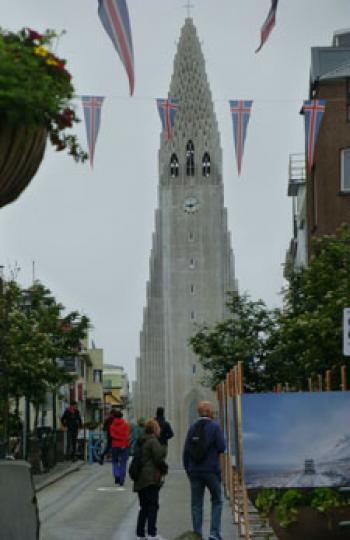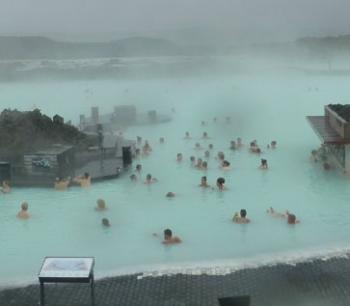Iceland
This item appears on page 56 of the December 2016 issue.
Iceland (Third of three parts)
Puffins are among the most colorful seabirds to be found in the North Atlantic. On my June 2016, 11-day adventure in Iceland, the standing joke within our group was that Day 9 would be puffin day, based on the near-guarantee of sightings that we had been given by our most amazing guide, Gugga Eiriksdóttir.
I was traveling (partially hosted) with ElderTreks on their annual circuit tour of that remote, European island nation.
Finally, at hand was our excursion to the 400-foot-high Dyrhólaey rock arch, overlooking the ocean and sweeping black-sand beaches, where the no-longer-elusive puffins — as well as a variety of other seabirds — were both nesting on the cliffs and adrift beyond the surf line.
With the magnificent seascapes and up-close nesting puffins, we had hit the daily double of nature photo ops.
Natural forces
Gugga, like many Icelandic guides, is a great folklore storyteller, and earlier that morning we had learned about Katla, the evil witch responsible for Iceland’s most devastating volcanic eruption, which took place in 1783.
At the Eyjafjallajökull Erupts Visitor Center, we were captivated by a 20-minute documentary about how a local farming family survived another massive eruption, which occurred in 2010, and completely rebuilt.
In late morning we continued westward, stopping to explore two dramatic, 200-foot-high waterfalls. At Skógafoss, I marveled at its raw power, and at Seljalandsfoss, those of us who were prepared to get drenched were able to walk on a gravel path under and behind the falls.
Geothermal mecca
The afternoon had us arriving in Hveragerði, a true geothermal paradise, located only about 40 miles east of Reykjavik. I was immediately enthralled by the pervasive hothouse (greenhouse) culture that dominated the landscape. All manner of fruits, vegetables and flora seemed to be flourishing under roof, protected from the elements and warmed by the unlimited supply of subterranean heat.
After our hotel check-in, I was ready to explore as much of Hveragerði as possible on foot. Having made the decision to skip dinner, I headed up Breidumork Street to the city park and toward the Agricultural University of Iceland. En route, I passed the beautiful Laugaskarð thermal bath, featuring a large mineral pool heated by underground springs.
From the hilltop at the edge of the campus I could survey the city, captivated by the scores of steam funnels puffing into the gentle blue sky. The earth there was alive and breathing and I could feel the pulse. Remarkably, on my hike, I was able to get very close to several of the steam vents, as none were fenced off.
At the back of the campus, I picked up a scenic-forest and meadow-laden hillside hiking trail that actually skirted the city but felt like complete wilderness. Eventually, I chose a spot to break from the trail and cross a large farm meadow with multiple bellowing steam vents. I had to find the only bridge that crossed the river separating me from the town.
Despite some trepidation, I guessed right; the bridge appeared, and, after crossing, I took a shortcut through the grounds of a large but most unpretentious residential medical spa, something common in Iceland, eventually winding my way back to the hotel. The sun was still shining brightly overhead, but it was well after 10 p.m.
Within Hveragerði, itself, was another geothermal park with hiking trails.
In addition, in the hills above the town, the Reykjadalur hot springs area had hiking trails to numerous remote soaking pools away from civilization.
I needed more time. My all-too-brief encounter with this remarkable town, fully powered by geothermal energy, will always be a special travel memory.
Blue Lagoon beckons
Our final stop before reaching Reykjavik was the Blue Lagoon geothermal mineral pool complex, located in an immense lava field. Despite the crowds, once you slip into the huge, warm-springs pool, relaxation tends to be immediate.
After taking advantage of the included mud facial option, I discovered a recently added pool extension where pool noodles were available, which allowed floating without effort, enhancing the experience. It also was possible to find pockets of cooler water that could moderate your body temperature and extend your pool time.
Despite the throngs, I was glad I did not miss this favored Icelandic treat.
Later, after checking into our Reykjavik hotel, well located along the waterfront esplanade, I did some exploring on foot and hatched a plan for a longer excursion the following morning.
Reykjavik meanderings
My final day in Iceland before an evening flight homeward, I was on an early-morning mission, heading down Laugavegur Street, Reykjavik’s popular shopping and restaurant district. I had asked Gugga to recommend her favorite bakery, as, in whatever country I think I can find it, I always try to take home a loaf of local sourdough bread. Sandholt (Laugavegur 36, Reykjavík; phone +354 551 3524, http://sandholt.is/en) was now on my radar.
Upon my arrival at the bakery, I was informed that all the Sandholt breads have a sourdough base, so I chose one, which, after returning home, proved to be so prized that it is extracted from the freezer by the slice only for special occasions.
Later, on a guided walking tour with Gugga, we covered some of the city’s historic Old Town sights, including the small parliament building and the Reykjavik Lutheran Cathedral (on Kirkjustræti), originally completed in 1796 and enlarged in 1847-1848. We had a brief amount of free time for viewing the expansive, glass Harpa Concert Hall & Conference Centre, a signature landmark fronting the harbor.
In the afternoon, we embarked on a final whirlwind driving tour around the capital. I was impressed by the cleanliness, the excellent roadways and the 60-plus kilometers of dedicated biking trails.
All too quickly, I was at the airport and saying good-bye to Gugga and my fellow travelers.
Tour basics
On this tour, all of our meals were included, and their overall quality and variety exceeded my expectations. As a pescatarian, I particularly enjoyed the salmon, the arctic char and other seafood options usually available at lunch and dinner. Other tour members constantly commented on the excellent quality of the lamb and pork. It seemed we always had a variety of fresh vegetables and salads, as well.
Breakfasts were buffet-style and included local favorites, such as herring, with no shortage of healthy options, including shots of cod liver oil. I adventurously imbibed most mornings.
The local beer was excellent though pricey at $8 to $9 a glass. Out of curiosity, I ventured into a liquor store once, but sticker shock set in and I departed empty-handed. Being able to drink the purest water imaginable directly from the tap everywhere was much appreciated.
Our accommodations around the island were a mix of small and mid-size properties, all well located, user-friendly and, at many stops, clearly the best options available. In most locations, we had free time for exploring on our own.
ElderTreks (597 Markham St., Toronto, ON, M6G 2L7, Canada; 800/741-7956, eldertreks.com) runs small-group tours for travelers ages 50-plus to adventure-oriented destinations around the world.
The tours’ activity-level ratings range from 1 to 5, with 5 requiring the greatest degree of fitness in order to successfully participate. Since most of the hiking and climbing opportunities on our Iceland tour were optional, as compared to required, the activity level of this tour was rated 2.
ElderTreks’ 2017 summer circle tour of Iceland is set for June 15-25. The land-only cost is $6,495 per person, double occupancy, and the single supplement is $1,295.
You may reach Randy at 80 America Way, Jamestown, RI 02835; 401/560-0350, randykeck@yahoo.com.

![On Reykjavik’s waterfront, the steel “Sólfar” (“Sun Voyager”) sculpture is not a depiction of a Viking ship but, according to the sculptor, Jón Gunnar Árnason (1931-1989), a “sun ship [that] symbolizes the promise of new, undiscovered territory.” Photos by Randy Keck](../sites/default/files/styles/width_800/public/Keck_504%20rgb-itok=AWRcTJoW.jpg)

